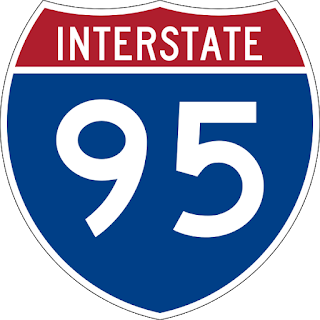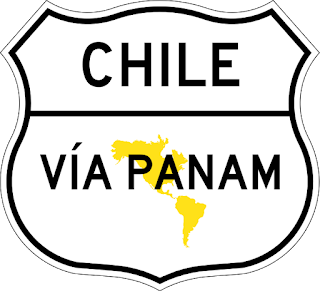Hello and welcome back to Old Highway Notes. This week we continue our drive up the old Highway 101 in San Diego County, California. Last week week we toured Chula Vista and the old highway route as described on the site EFGH.com, I marked the turn they mention on the map with a pin to help you see it.
As Broadway enters National City becoming National City Blvd, very little is there to show you that this was once the main North/South Highway in the area. The area is now the "Mile of Cars" and one of the more popular places to place a car dealership in San Diego County. It is pleasant enough and evokes Southern California since few things are more emblematic of Southern California than palm trees and cars. If you were there you would find you were close enough to the ocean to smell salt in the air. This video from Chula Vista Productions provides us with a view out the windshield.
Stay with me here. National City makes me think of cars. Cars make me think of Hot Rods. Hots Rods Make me think of Rockabilly Music. Rockabilly music makes me think of the 80's. The 80's make me think of MTV. All of which make me think about the comedic cult roots rocker Mojo Nixon. Mojo Nixon makes me think of his straight man sidekick and band mate Skid Roper. Skid Roper makes me think of National City because this is where he came from.
Richard Banke was born in 1954 in National City, CA. He first achieved prominence in 1983 when he began performing in dive bars in the San Diego area with his musical partner Neill McMillan. Richard would use the stage name Skid Roper and Neil would perform under the pseudonym Mojo Nixon. Skid was the sort of the straight man and sidekick to Mojo, who was the real star of the act. He would accompany Mojo on washboard, mandolin and other instruments. In 1984 they released a demo following up with their debut album in 1985. The description found on the YouTube Mojo Nixon Theme Page describe him well:
The duo would record a half dozen albums before splitting in 1989. Each continuing on with other projects, neither with a lot of success (although Mojo seemed to do better). They have reunited a few times recently for special occasions. Skid still lives in National City and performs with Skid Roper Band in the San Diego area.
Mileage Stats
Route 66: 0 Miles/1 State/466 Tracks/93 Videos/22 Posts
Highway 101: 13 Miles/1 State/433 Tracks/129 Videos/16 Posts
Interstate 95: 0 Miles/1 State/10 Tracks/20 Videos/4 Posts
You Can Give me a Karma Donation Via PayPal
mile 04.63 - Cross over the Otay River and enter Chula Vista. Old U.S. 101 becomes Broadway.
mile 08.87 - Enter National City. Old U.S. 101 becomes National City Blvd.
mile 10.57 - Turn left onto Civic Center Dr.
mile 10.93 - Pass under Interstate 5 and turn right onto Harbor Dr., which was part of Old U.S. 101. It has bike lanes in most places, although the pavement is quite rough in spots. Be especially careful when crossing railroad tracks.
As Broadway enters National City becoming National City Blvd, very little is there to show you that this was once the main North/South Highway in the area. The area is now the "Mile of Cars" and one of the more popular places to place a car dealership in San Diego County. It is pleasant enough and evokes Southern California since few things are more emblematic of Southern California than palm trees and cars. If you were there you would find you were close enough to the ocean to smell salt in the air. This video from Chula Vista Productions provides us with a view out the windshield.
Skid Roper, Mojo Nixon's Sidekick
Stay with me here. National City makes me think of cars. Cars make me think of Hot Rods. Hots Rods Make me think of Rockabilly Music. Rockabilly music makes me think of the 80's. The 80's make me think of MTV. All of which make me think about the comedic cult roots rocker Mojo Nixon. Mojo Nixon makes me think of his straight man sidekick and band mate Skid Roper. Skid Roper makes me think of National City because this is where he came from.
 |
Richard Banke was born in 1954 in National City, CA. He first achieved prominence in 1983 when he began performing in dive bars in the San Diego area with his musical partner Neill McMillan. Richard would use the stage name Skid Roper and Neil would perform under the pseudonym Mojo Nixon. Skid was the sort of the straight man and sidekick to Mojo, who was the real star of the act. He would accompany Mojo on washboard, mandolin and other instruments. In 1984 they released a demo following up with their debut album in 1985. The description found on the YouTube Mojo Nixon Theme Page describe him well:
One of the most outsized personalities on college radio in the '80s, Mojo Nixon won a fervent cult following with his motor-mouthed redneck persona and a gonzo brand of satire with all the subtlety of a sledgehammer. Nixon had a particular knack for celebrity-themed novelty hits ("Elvis Is Everywhere," "Debbie Gibson Is Pregnant With My Two-Headed Love Child," "Don Henley Must Die"), but he was prone to gleefully crass rants on a variety of social ills ("I Hate Banks," "Destroy All Lawyers," "I Ain't Gonna Piss In No Jar"), while celebrating lowbrow, blue-collar America in all its trashy, beer-soaked glory. All of it was performed in maximum overdrive on a bed of rockabilly, blues, and R&B, which earned Nixon some friends in the roots rock community but had enough punk attitude -- in its own bizarre way -- to make him a college radio staple during his heyday.
The duo would record a half dozen albums before splitting in 1989. Each continuing on with other projects, neither with a lot of success (although Mojo seemed to do better). They have reunited a few times recently for special occasions. Skid still lives in National City and performs with Skid Roper Band in the San Diego area.
Playlist Additions
I like Mojo Nixon a lot. He is definitely a pioneer of the alt country sound and his songs were sort of like Weird Al Yankovik except that played Americana originals rather than polka parodies. Like Yankovik it could be some of the funnier stuff on MTV back in the 80's when the station still played videos. I am almost emabarassed about the fact that I only have one official release and one live audience recording in my collection. The additions to this week list are:
Album: Root Hog Or Die Mojo Nixon and Skip Roper
Mojo Nixon and Skip Roper 1989
1989
- Debbie Gibson Is Pregnant With My Two Headed Love Child
2:07
- (619) 239-King
6:02
- This Land Is Your Land
6:00
- Pirate
Radio
3:21
- Chicken Drop
5:58
- Tennesse Jive
2:39
- Louisiana Liplock
4:19
- I'm A Wreck
2:45
- Legalize It
2:28
- Burn Your Money!
5:17
- Circus Mystery
3:35
- She's Vibrator Dependent
5:04
- High School Football Friday Night
6:56
- Twilight's Last Gleaming 4:25
- I'm In a Gin Guzzlin' Frenzy 3:43
- Stuffin' Martha's Muffin 3:56
- Moanin' With Your Momma 5:24
- I Hate Banks 5:16
- Buzzard Blues (Skid Roper) 4:08
- Rockin' Religion 5:20
- Mushroom Mania 4:40
- Jesus At McDonald's 6:37
Moving On
National City gave the world Skip Roper, but it also sent a far more successful artist into the world as well. Join us in 3 weeks as we return to old Highway 101 in San Diego County for more Old Highway Notes. Don't forget to stop by next week when we return to Interstate 95 in Miami to close out our prelude to destruction in the hippie scene. In two weeks we will back Chicago on Route 66 looking at the history of blues music in that city. Thanks for stopping by and until we meet again, "Hi-ho mateys yo! Turn on the Pirate
Radio, land of the free and home of the brave, FCC crawl in your grave. Crawl in there, you lily-livered scabs!"
Mileage Stats
Route 66: 0 Miles/1 State/466 Tracks/93 Videos/22 Posts
Highway 101: 13 Miles/1 State/433 Tracks/129 Videos/16 Posts
Interstate 95: 0 Miles/1 State/10 Tracks/20 Videos/4 Posts
And Now A Word From Our Sponsor...
If you like what you have read here I'd like to ask you a favor. If you purchase any item on Amazon after you link to them in the Amazon banner below, I will get a little something from them. It doesn't cost you any extra and I cannot see what you have purchased.
With your help, I can keep the show on the road for you.
With your help, I can keep the show on the road for you.
You Can Give me a Karma Donation Via PayPal
Keep Traveling!
To read more Old Highway Notes, choose an off ramp and click on the highway sign:
Vista Points
Be social, Get more info, View our YouTube playlist and more













